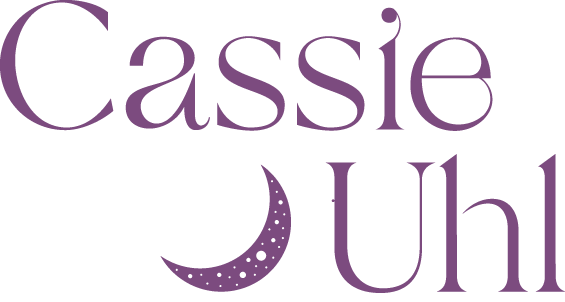7 Tarot Myths Debunked
In our culture, there is no shortage of myths about tarot. Many of us were raised with the perspective that tarot cards are “scary” or that they have something to do with the devil.Misinformation is rampant, but the truth is, tarot can be a powerful tool to help you hone your intuition, connect with yourself, deepen your relationship with spirit/universe/guides, make decisions, and more. In this post, I’ll be debunking some major myths about the tarot so that you can feel freer to work with the tarot in a way that feels really good to you.

In our culture, there is no shortage of myths about tarot. Many of us were raised with the perspective that tarot cards are “scary” or that they have something to do with the devil.
Misinformation is rampant, but the truth is, tarot can be a powerful tool to help you hone your intuition, connect with yourself, deepen your relationship with spirit/universe/guides, make decisions, and more.
In this post, I’ll be debunking some major myths about the tarot so that you can feel freer to work with the tarot in a way that feels really good to you. Check them out below!

MYTH 1: YOU MUST BE GIFTED YOUR FIRST DECK
This is a super common myth! Have you ever heard that you can’t buy your own deck and you must be gifted your first deck?
Tarot reader and author Theresa Reed told Refinery 29 that this myth is “total rubbish.” She says, “If I would have waited around for that to happen, I might not have started working with the tarot as soon as I did — if ever.”
I feel the same way. To me, this myth is just a form of gatekeeping in the tarot community. No one is exactly sure where this myth comes from, but it may be a legacy of 19th-century closed occult societies.
Regardless of where it comes from, there’s nothing wrong with buying a deck for yourself — tarot is a folk magic practice, and it belongs to the people, so you don’t need permission from someone else in the form of a gifted deck to start your practice. If you feel attracted to working with the cards - pick yourself up a deck!
Give this post a listen here.
MYTH 2: TAROT IS EVIL
Another variation of this myth is that tarot cards have something to do with the devil. I believe this myth originates from Christianity. There are various verses in the Bible about divination, “sorcery,” and mediumship that have been translated to be a condemnation of all occult, divination, and spiritual tools outside of Christianity.
This myth is also often perpetuated by the media, whose portrayals of tarot readers and cards have often been abysmal. Media is intended to be sensational, which means tarot cards are portrayed as evil or used for devil worship. Common tarot scenes show the “scary” cards with literal meanings - like the death card when someone is going to die or the devil card when something evil is going to happen.
This myth is easy to debunk when I ask myself a few questions:
Who benefits from me believing this myth (whether it’s dogmatic religion that wants me to rely on their truth rather than find my own through a tool like the tarot or a TV show that wants to make interesting TV and get viewers)?
Do I really think that Barnes and Noble are selling a tool to connect with the devil?
What have my experiences with the tarot been like?
Like with most things, we can use tarot in helpful ways and not so helpful ways. But the cards are not inherently evil, and we can use them in ways that support ourselves and our highest good.
MYTH 3: THE DEATH CARD MEANS YOU’LL DIE
Ah, another TV myth. Like I mentioned above, this card is often portrayed as a super scary card, and when it shows up in a reading, it could mean you’re going to die.
All tarot cards are neutral. There are no good or bad cards. Some cards may be more uncomfortable than others (and this will change depending on every person!), but no cards are in and of themselves bad.
So no, the death card doesn’t mean you’ll die. Usually, it means a transformation of some kind. It refers to deaths of a different kind - deaths of relationships, ways of being, of selves you have been, dreams, etc.
In the United States, we have a cultural aversion to the idea of death, and I think we disconnect from the idea of death happening all around us all the time throughout our lives. The death card breaks this fiction and reminds us that death is a natural process unfolding throughout the seasons and throughout our lives and that it clears the way for our evolution and growth.
That can be scary, too, of course - change is often hard. But next time you pull the death card, you can lean into that kind of scary and not worry that you’re going to die literally.
MYTH 4: TAROT IS ONLY USED TO TELL THE FUTURE
Tarot can certainly be used to predict the future. But in my belief, the future is not set. The future is always changing, and we are actively creating it with our energy and our decisions each day.
When I pull more predictive cards, I like to remember that I have the power to change the future and make different decisions if I don’t like the outcome card in front of me. This is a way to use tarot that feels more empowering and more honest.
But more often than not, I’m not using tarot cards to tell the future, and I think many modern readers will tell you the same. Fortune telling is one powerful way to use the tarot. Still, there are many other ways to work with the cards that can be even more powerful, in my opinion: to connect with yourself, to understand your inner world, to process feelings, to understand current energies, to make support decisions, to connect with your intuition, to heal, and more.
MYTH 5: YOU NEED TO BE PSYCHIC TO READ THE TAROT
I think this myth is rooted in the previous one: that tarot is only used for fortune-telling. When we know that tarot has many purposes, we understand that you don’t need to be psychic to read the cards.
You don’t need to be psychic to connect with your intuition, which is the most important piece of reading cards, in my opinion. Intuition can sometimes require some uncovering and trust work (click here for 3 daily actions to improve your intuition and here for 5 tips to learn how to trust your intuition), but it is innate and available to us all.
Reading the cards with your intuition could look like noticing how you feel about certain cards, paying attention to memories or images that come up around cards when you pull them (even if they don’t match with the traditional meaning of the cards), or meditating with cards to receive messages from them.
But regardless, tarot cards have meanings. You can study those meanings from different books and teachers and develop a rich and fulfilling tarot practice this way! As you learn to trust your intuition a bit more, weaving that practice into your work with your cards can add another meaningful layer.
MYTH 6: YOU CAN NEVER LET ANYONE ELSE TOUCH YOUR TAROT CARDS
This myth is rooted in the idea that the cards themselves contain magic or are magical. In my opinion, the cards themselves are a neutral tool and conduit. They don’t contain their own magic; youare the magic. So it doesn’t matter if other people touch them because they can’t take anything away from them.
If you don’t like other people touching your cards, that’s totally fine! But there’s no need to keep others from touching your cards out of fear that it will take away the deck’s magic or shift the cards' energy irreversibly.
In fact, many readers (myself included) like to have the querent shuffle the cards to infuse their energy and intention into the deck for a more powerful reading. If you feel the same, a regular cleansing process with your deck (click here to learn how to cleanse your cards) is all you need to keep your deck’s energy clear.
MYTH 7: REVERSED CARDS ARE BAD
When a card is reversed, that simply means it came out of your deck upside-down. Reading reversed cards in the first place is a matter of preference: some readers read them, and some will just flip the cards right side up and go with that meaning. As with most things tarot and intuition, there’s no right or wrong answer. Just do what works for you!
But whether you choose to read reversals or not, reversed cards are not inherently bad. They bring a different energy, certainly, and can add a layer of clarity to a reading, but they’re nothing to be afraid of. Reversed cards can mean blocked energy, more introspective energy, a softer meaning of the card, or maybe some fear around that card’s theme.
WANT TO LEARN MORE ABOUT THE TAROT?
Check out some of our other tarot blog posts:
6 Tips to Learn the Tarot Card Meanings Quickly
So you got your first tarot deck, did a couple of solo readings, and then never picked it up again? Or, you work with tarot regularly but find yourself frustrated with being so reliant on the guidebook? One of the biggest hurdles people face when getting started with tarot is learning the card meanings. This kept me from diving deep into the tarot for years, too; I get it!There are much easier techniques to learning the meanings of all of the cards besides memorizing a guidebook word for word for 78 different cards.

So you got your first tarot deck, did a couple of solo readings, and then never picked it up again? Or, you work with tarot regularly but find yourself frustrated with being so reliant on the guidebook? One of the biggest hurdles people face when getting started with tarot is learning the card meanings. This kept me from diving deep into the tarot for years, too; I get it!
There are much easier techniques to learning the meanings of all of the cards besides memorizing a guidebook word for word for 78 different cards. Not only is memorizing a guidebook of 78-card meanings not very feasible, but it’s also an intuitive disservice in working with the tarot.
What if I told you that you could have a robust knowledge of all 78 cards by learning only 36 correspondences? I know 36 is nothing to sneeze at, but here’s the thing, the 36 correspondences I’ll layout in this post will not only help you understand the energy of each tarot card but will also help you in nearly all other facets of spellwork and magick.
What are correspondences?
Correspondences are simply energies that play well together or match. Each card of the tarot has at least a couple of correspondences, and when you better understand each card's correspondences, you’ll also understand the energy of each card. The correspondences associated with tarot are not unique to tarot and relate to numerology, astrology, witchcraft, and more. Plus, there’s a good chance that you’re already familiar with some of the correspondences that I’m going to outline in this post. If you are, that’s great! You’re already a step ahead.
Before you dive in, correspondences and their meanings can be rich and deep. They can also vary somewhat from person to person. What I share here is enough to get you started to build a strong foundation, but I recommend digging deeper into the ones you’re less familiar with.
Dive deeper into tarot correspondences in my book, Understanding Tarot. You might also find that reading an introductory book on numerology or astrology will really deepen your understanding of those specific correspondences. You can also read up on numerology and the four elements right here on the blog! Click here for more on the elements and here for more on numerology.
Let’s dive in. Here are 6 tips to help you learn the tarot card meanings quickly.
1. Understand your learning style!
Before we jump into understanding the correspondences of tarot, you need to get super clear about how you learn and use that method as we dive into the correspondences. If you’re a visual learner, get a journal and start drawing and writing down what the correspondences below mean. If you’re an auditory learner, consider listening to an audiobook about the correspondences listed below. If you learn by doing, continue working with your tarot deck to weave this knowledge into your readings. Not sure how you learn best? Try a few different ways listed above and see what sticks.
2. Understand Basic Numerological Meanings
The largest part of a tarot deck, and for many, the trickiest cards to learn, are the numbered suit cards of the Minor Arcana (think 2 of cups and 4 of wands, etc.) Understanding the basic numerological meanings will make you feel MUCH more confident with these cards. There are ways to use numerology in the Major Arcana too, which you’ll be able to learn more about in my new book. For the minor arcana, use these numerological meanings to give you clues about what each card means.

New beginnings
Balance
Creativity
Foundations
Change
Partnership
Intellect
Mastery
Endings
This one is kind of unique to tarot because, in traditional numerology, you always reduce down to a single-digit between 1-9. Fortunately, the meaning often in regards to the tarot is pretty obvious. It points to an end of a cycle and transitioning to a new phase. It has a slightly different feel than 9 in that it signals a willingness to move on.
3. Understand the 4 Elements
Earth, air, water, and fire are, in my opinion, foundational in any magickal or divination practice. The elements are the energies that we’re made of and can be utilized in nearly all facets of a spiritual and magickal practice! Each of the four elements corresponds with a suit of the minor arcana, shown here.
Cups- Water
Pentacles- Earth
Swords- Air
Wands- Fire
Now that you know more about the meanings associated with the numbered cards of the minor arcana, you can also apply the corresponding element. Now you have two things to go off of to understand the energy of each card better. Here’s a list of how the energy of the elements express themselves.

There are ways to apply your understanding of the elements to both the minor arcana's court cards and the major arcana. I discuss these more in my book, but this is a great place to start!
4. Understand Zodiac and Planetary Meanings
We’ll begin to transition more to the major arcana for this one. Each of the major arcana cards corresponds with either a planet or a zodiac sign, giving it a unique energy.
The Fool - Uranus
The Magician - Mercury
The High Priestess - The Moon
The Empress - Venus
The Emperor - Aries
The Hierophant - Taurus
The Lovers - Gemini
The Chariot - Cancer
Strength - Leo
The Hermit - Virgo
Wheel of Fortune - Jupiter
Justice - Libra
The Hanged One - Neptune
Death - Scorpio
Temperance - Sagittarius
The Devil - Capricorn
The Tower - Mars
The Star - Aquarius
The Moon - Pisces
The Sun - The Sun
Judgment - Pluto
The World - Saturn
Here are examples of how these energies express themselves. Zodiac Signs

Planetary Meanings
Sun - Ego
Moon - Subconscious
Mercury - Communication
Venus - Love
Mars - Warrior
Jupiter - Expansion
Saturn - Restriction
Uranus - Revolutionary
Neptune - Dreams
Pluto - Transformation

5. Learn how Astrological Energies Correspond with the Elements
I imagine correspondences as a web of intersecting energies that play off of each other. When you understand how these different energies match up or repel each other, it will take your understanding of the tarot cards' meanings to a deeper level.
Each of the zodiac signs and planets corresponds to an element. Now, with your understanding of the elements and basic astrology, you can weave these meanings together. Here’s a list of how the planets, zodiacs, and elements correspond with one another.
Aries - Mars - Fire
Taurus - Venus - Earth + Water
Gemini - Mercury - Air
Cancer - Moon - Water
Leo - Sun - Fire
Virgo - Mercury - Earth + Air
Libra - Venus - Air + Water
Scorpio - Pluto - Water
Sagittarius - Jupiter - Fire
Capricorn - Saturn - Earth
Aquarius - Uranus - Air
Pisces - Neptune - Water
With this information combined, we can see that the Empress corresponds to Venus, the earth element, and Taurus. Therefore the Empress card relates to love, beauty, and creation from an earthly and material perspective.
6. Pair this Knowledge with your Intuition
Think of all of this correspondence knowledge as a way to bolster your intuition. They’re not the end all be all of learning the tarot, but they go a LONG way! The more comfortable and confident you become in understanding these correspondences, the easier it will be for you to intuit the card meanings for yourself and others without a guidebook. The correspondences are better than a guidebook because they give you nudges and insights about what the cards have to tell you, rather than a definitive answer.
Learn more about building up your intuitive muscles here in this previous post.
Now it’s time for you to put these tools into practice. Find a way to learn them that works for you, and watch your ability to understand the tarot card meanings flourish!
Dreamwork 101 // What is Dreamwork and How to Get Started in 5 Steps
Dreamwork is the practice of tending to our relationship with our dreams. We’re dreaming every night, but many of us barely remember our dreams, or if we do, don’t spend much time thinking about them or working with them.(How often have you dismissed a dream as, “oh, it was just a dream?”)
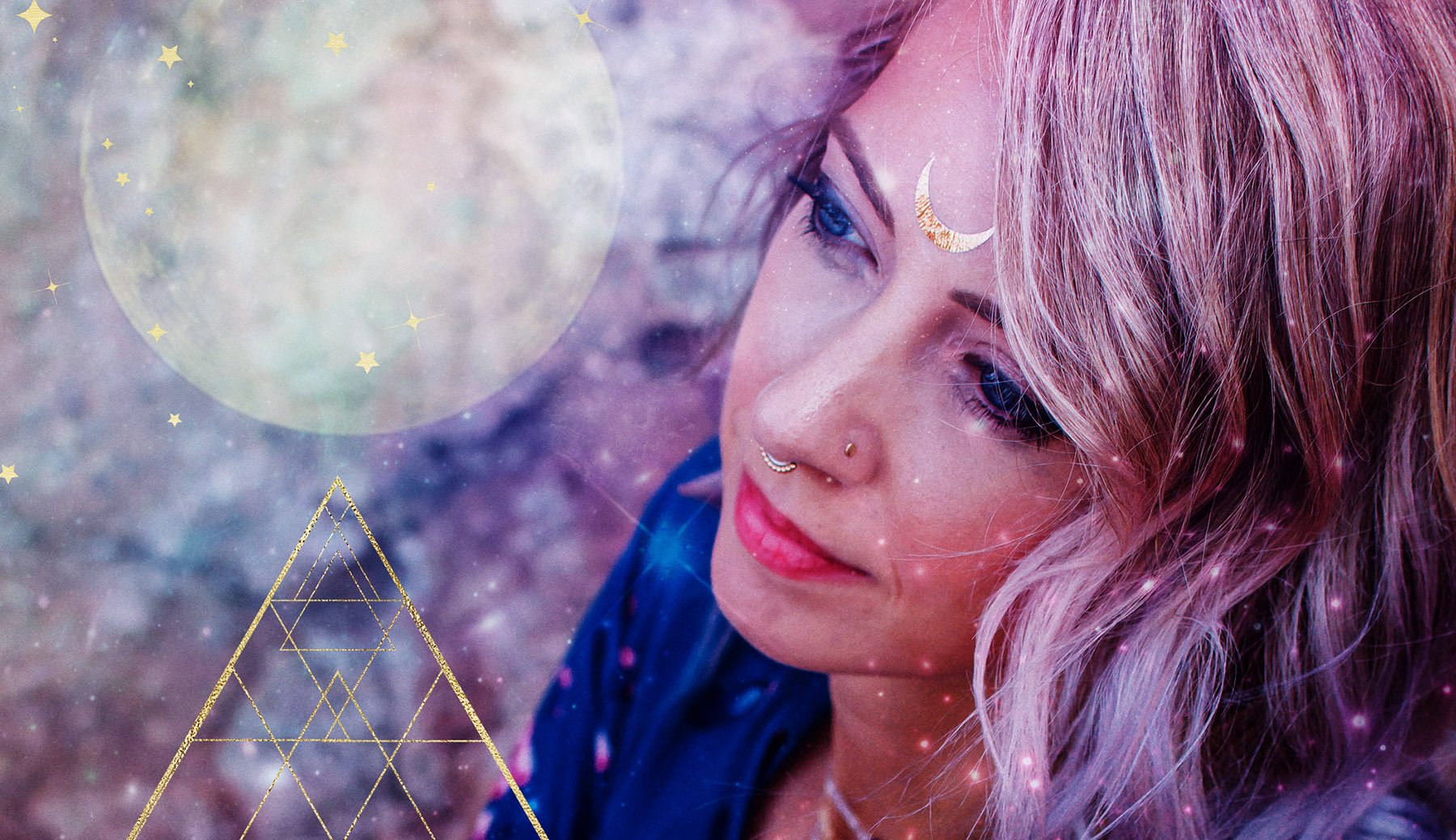
Dreamwork is the practice of tending to our relationship with our dreams. We’re dreaming every night, but many of us barely remember our dreams, or if we do, don’t spend much time thinking about them or working with them.
(How often have you dismissed a dream as, “oh, it was just a dream?”)
But dreams can have a lot to teach us and offer us when we enter into a deeper relationship with them. The dreamworld is rich with feelings, desires, needs, and possibilities. Our understanding of what the dreamworld evokes and presents can support our physical lives and our connections to ourselves.
In this blog post, I’ll share a bit about how to start a dreamwork practice of your own.
Dreamwork Lineage
First, I’d like to share my dreamwork lineage. What I know about dreamwork comes from the work of these folks in particular, as well as my own intuition and my ancestors:
These are wonderful people to go deeper into dreamwork with if you feel so called.
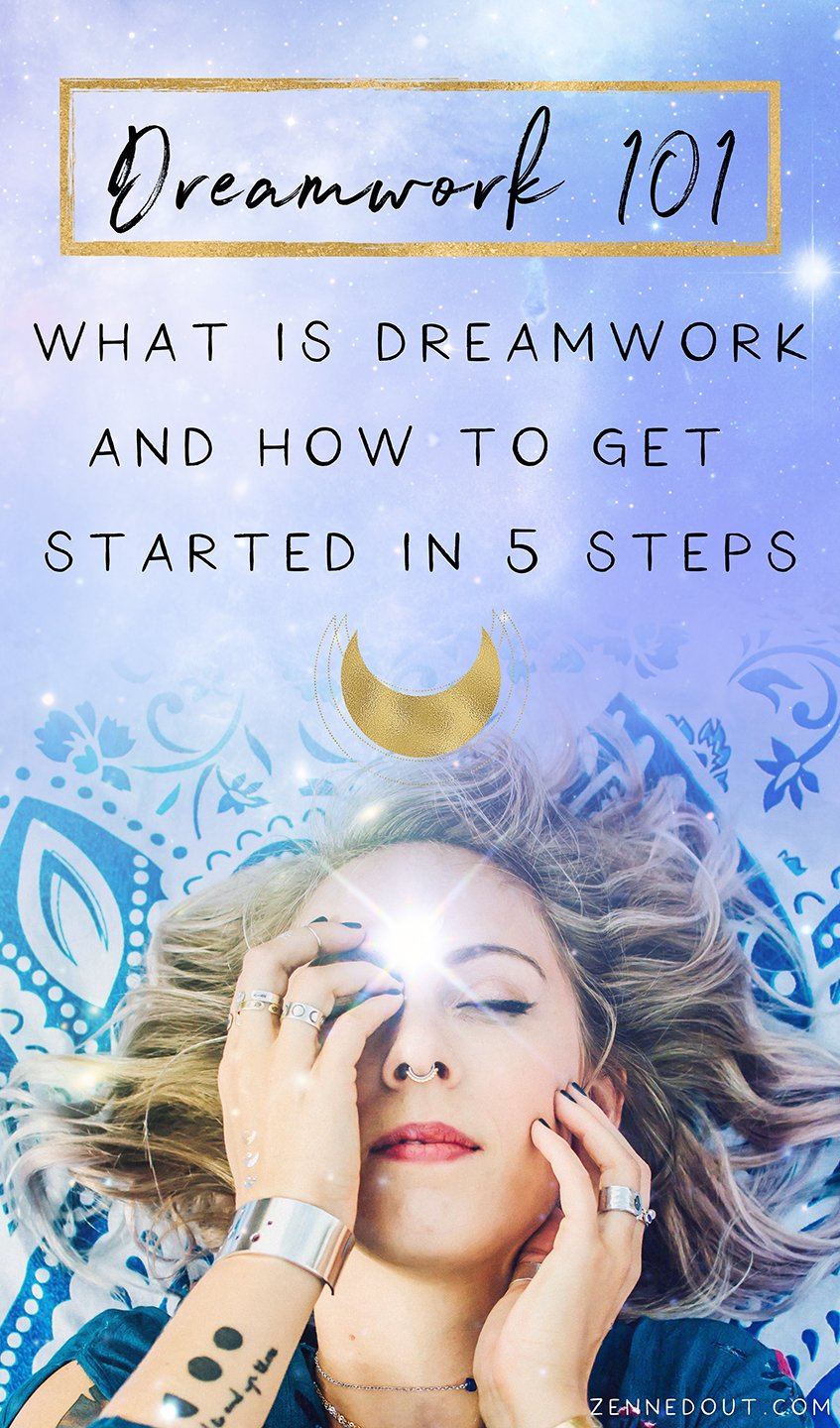
1. Support Dream Recall + Sleep
The simplest of ways to begin supporting your dreaming is by supporting sleep and dream recall. It’s difficult to consciously work with our dreams if we’re not sleeping well or can’t remember our dreams when we wake up. Everyone is different, but here are some things you might like to explore to support your sleep:
Set screen time boundaries for a certain amount of time before bed
Drink a tea to support your sleep, like chamomile (always do your own research and check with a professional before ingesting herbs)
Create your own sleep ritual that helps you shift into rest mode
Meditate and/or do a gentle, restorative yoga practice
Take a few minutes to journal brain-dump style to help clear your mind.
To support your dream recall, there are a few things I find helpful:
Set an intention to dream and to remember your dream(s) before you go to sleep (you can write this down, say it out loud, or just tell it to yourself silently)
Take a few minutes in bed in the morning before you get out of bed (or look at your phone) to give yourself space to remember your dream.
Create a dream altar and meditate at it before bed to welcome your dreams to come
Pay attention to the dreams you do receive by tending them (more on that below!)

2. Start a Dream Journal
This is probably the number one tip anyone you ask about dreamwork will give you, and with good reason! A dream journal creates a container for tending your dreams, helps solidify your intention to connect with your dreams, and helps you understand your dreams.
I recommend choosing a dedicated journal for your dreamwork and placing it on your dream altar when you’re not using it if you have one. As soon as you wake up (definitely before you look at any devices), put pen to paper and record your dream. Try recording your dreams in the present tense to honor its aliveness (for example, instead of "I was walking by a river,” try “I’m walking by a river).
If it feels available to you, you might like to marinate in the dream in bed for a few minutes before actually getting up and reaching for your journal to record.
3. Explore Dream Feelings & Textures
After you record your dream, there are many ways to work with it more deeply and explore the messages it might have for you.
I like to explore the dream textures: what are the textures, sights, smells, tastes, sounds of the dream? What do those senses mean for you and evoke for you? How do they make you feel? How does the dream, in general, make you feel?
4. Understand Dream Associations
As you work with the dream you’ve recorded, notice what stands out to you. Maybe your red dress feels particularly alive, or the hawk sparks something for you, or you feel curious about a figure in your dream.
Whatever you feel curious about, do a bit of freewriting about it. List out: what does this thing make you think of? How does it make you feel?
For example, some associations that come up with hawks for me:
Hawk feather
Maggie Smith’s poetry book Good Bones
Mothers
Protecting your children
Imagination
Play
Notice how I’m not so focused on the hawk itself, but I follow the threads of what each thing is associated with! Now I have something interesting to work with and can ask myself questions like, "what’s my relationship with play right now?"
Some of the associations you make might really surprise you and can offer deeper insight into your dream.
5. Assign Dream Correspondences
As you continue to work with your dreams, you start to develop some personal symbols and correspondences.
Like you saw above in my example with the hawk, I could make a section in my journal where I note that hawk led me to mothers and children and play. When I see a hawk again in my dream, I have that reference and can ask myself if/how it applies to this dream.
Over time, you can deepen your understanding of your own personal dream symbols and correspondences. I love this practice so much because, to me, it’s not about what a certain symbol means but about what it means to you, how it feels in your body, how it resonates with your ancestry. That’s what feels potent and powerful!
Dreams Aren’t Your Personal Vending Machine
It feels important to state that working with dreams isn’t just asking a question and receiving an answer. Generally, it’s not a simple or linear way of working. There isn’t one true or hidden meaning that we need to uncover.
In my eyes, dreams and the dreamworld are alive. So it truly is a practice of engaging in relationship with, of exploring. You might like to ask yourself, "how can I be in equal exchange with my dreams?" How can I honor the dream world and not just extract from it?
Dreams have such potential to expand us out of binary thinking and into visionary possibilities, especially if we acknowledge that power and allow them to take us there!
Going Deeper with Your Dreams
Another way to explore dream tending and go a bit deeper is by asking for a dream. I share how to do this in the dreamwork ritual I shared for Pisces season, which you can find here.
Feel free to contact us and share: how is your dream practice going? How is your relationship with your dreams evolving?
Dreamwork Ritual for Pisces Season + Card Spread
Pisces, our mutable water sign and last sign of the zodiac, evokes the artist, the mystic, the dreamer, in all of us with its connection to music, poetry, spirituality, and the dream world.In this blog post, I’ll be sharing a card spread and a ritual for Pisces season.
Card Spread & Sigil Ritual for Aquarius Season
Welcome to Aquarius season! Our fixed air sign, Aquarius energy is about authentic expression, bringing forth the new age and the next world, and upgrading the collective to its highest expression.To learn more about Aquarius energy, you can check out this blog post. In this post, I’ll be sharing a card spread and a sigil ritual to help you tap into the healing invitations of the Aquarius season. Practice these Aquarius offerings together or separately, whatever feels best for you. Scroll down to explore both of them!
Seeing the unseen // Scrying 101
Scrying is an ancient divination practice where you connect with your intuition and work to make the unseen seen by gazing onto a reflective surface.Scrying is a broad practice, therefore mentions of it pop up in a variety of places throughout history. Scrying is referenced in ancient Egypt, England, Greece, and Persia (to name a few.) Nostradamus reportedly relied on scrying for many of his predictions as well. The tools you can use for scrying are as vast as its history. You can use crystals, water, the moon, fire, smoke, a mirror, or really any reflective surface.
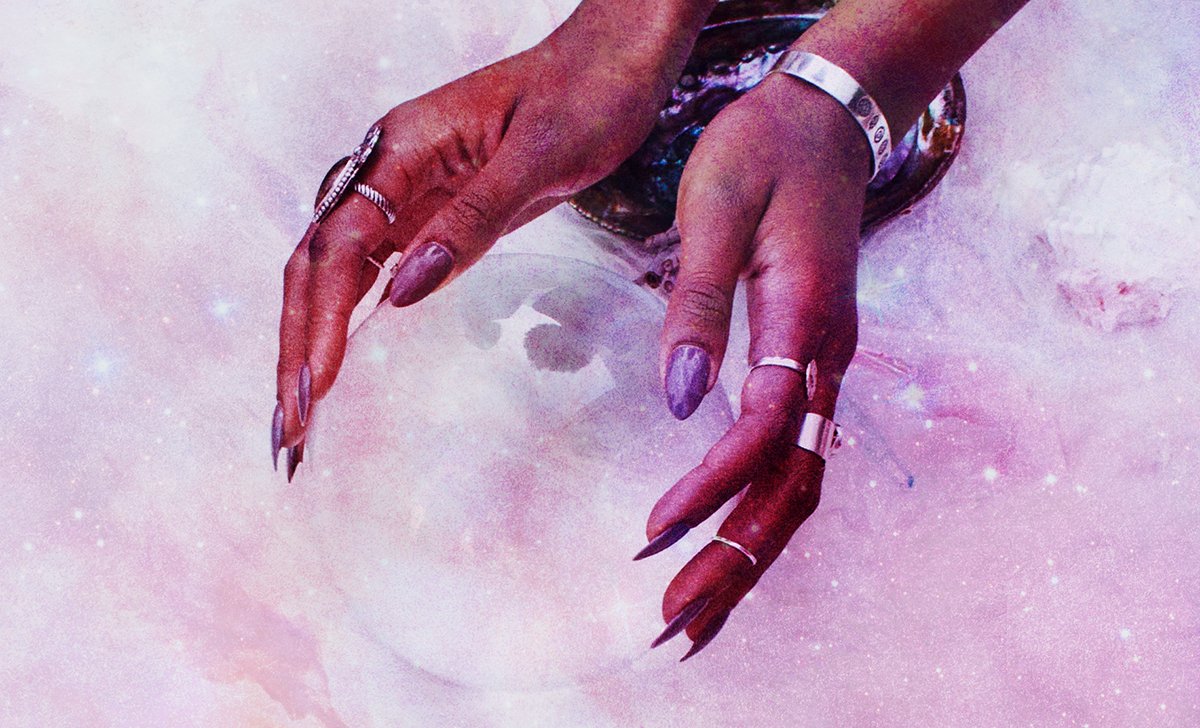
Scrying is an ancient divination practice where you connect with your intuition and work to make the unseen seen by gazing onto a reflective surface.
Scrying is a broad practice, therefore mentions of it pop up in a variety of places throughout history. Scrying is referenced in ancient Egypt, England, Greece, and Persia (to name a few.) Nostradamus reportedly relied on scrying for many of his predictions as well.
The tools you can use for scrying are as vast as its history. You can use crystals, water, the moon, fire, smoke, a mirror, or really any reflective surface.

Artwork copyright Cassie Uhl 2020-infinity, please credit if shared.
Though clear crystal balls work for scrying and are commonly shown as a scrying tool, it is not the only kind of crystal used for this practice. Black obsidian mirrors are commonly used for scrying, but really any crystal with a reflective surface will do. You may even decide that you'd like to use a specific crystal in alignment with your desires for a scrying session. Sphere, larger palm stones, and flat mirrors or slabs all work well for this practice.
As varied as scrying is, the piece that remains consistent is the desire to reach an altered state to receive visions. The visions you receive from scrying could be from spirit or your subconscious. That’s for you to decide.
I love scrying for its power and simplicity. In this post, I’ll be sharing how to scry! Keep reading for five steps to try scrying for yourself.
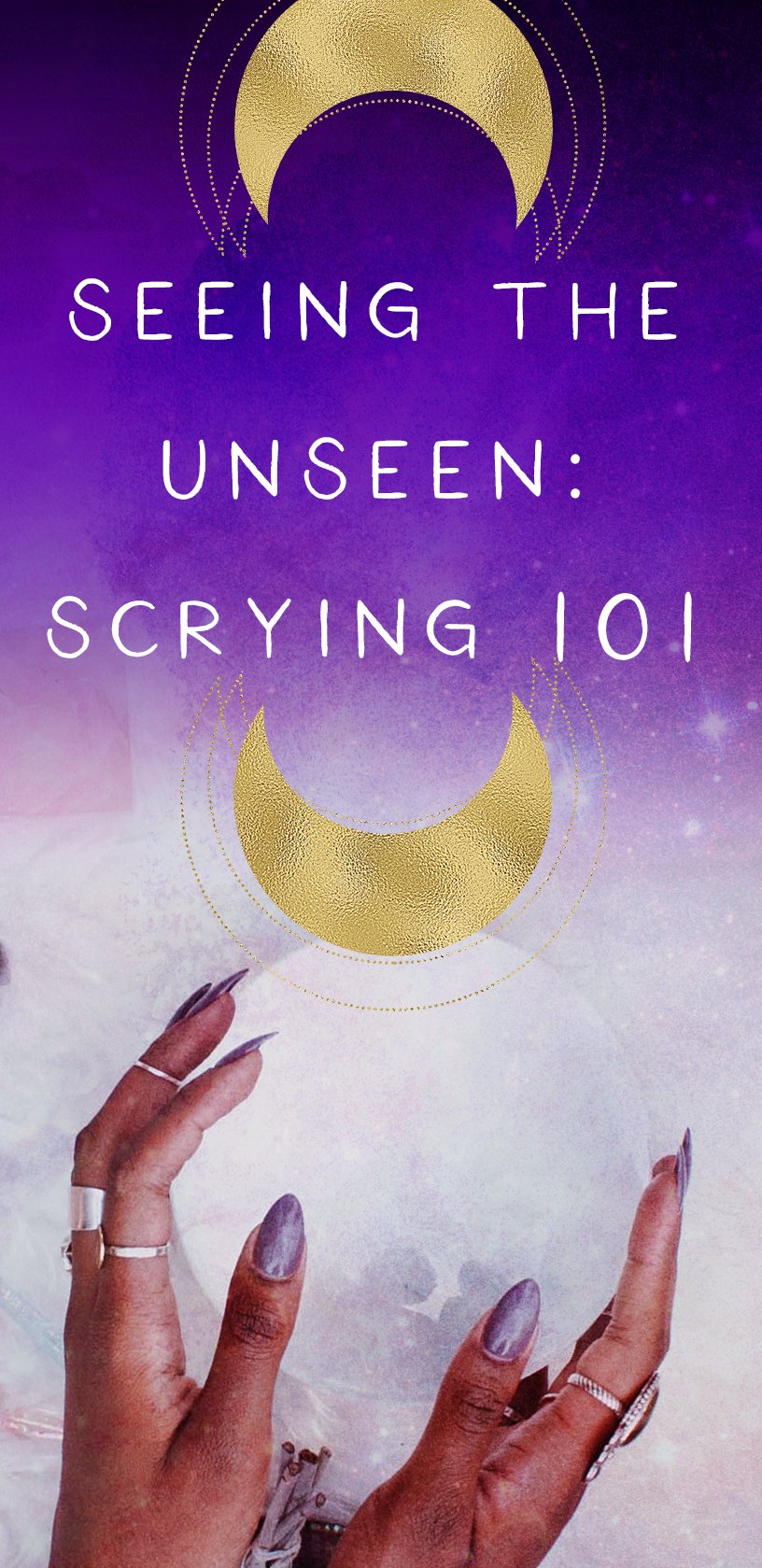
A note on working with the moon. The full moon and the dark moon are ideal times to try this practice. I like scrying with the full moon to help illuminate and the dark moon for going within and accessing intuition. Don’t let the phase of the moon stop you from trying this practice; these are just suggestions.
Getting started with scrying:
To begin your scrying practice, create a ritual space for yourself, and gather your bowl and water. (As I walk you through scrying, I’ll be using the example of a bowl of water, but remember that there are many other ways to scry that I shared above.)
You’ll want to be in a dark room with only one or two candles lit.
Once your space is ready, enter a trance state through meditating, energy work, drumming, chanting, breathwork, or any other practice that helps you drop into your subconscious mind.
Once you feel like you’re in an altered state of consciousness, relax your eyes and gaze into your bowl of water. Breathe deeply, let yourself soften, and ask a question silently (for example, what is holding me back in X situation? Or what do I need to know about Y?).
Gaze into the bowl and let yourself see what you see. It may take time for images to come up, but if you stay focused and present, they will. Allow the images, words, and sensations to flow, rather than holding on to them tightly.
When you feel like you’re done, you’re done! Spend some time journaling about what you felt and saw to help you answer the questions you came to receive answers for.
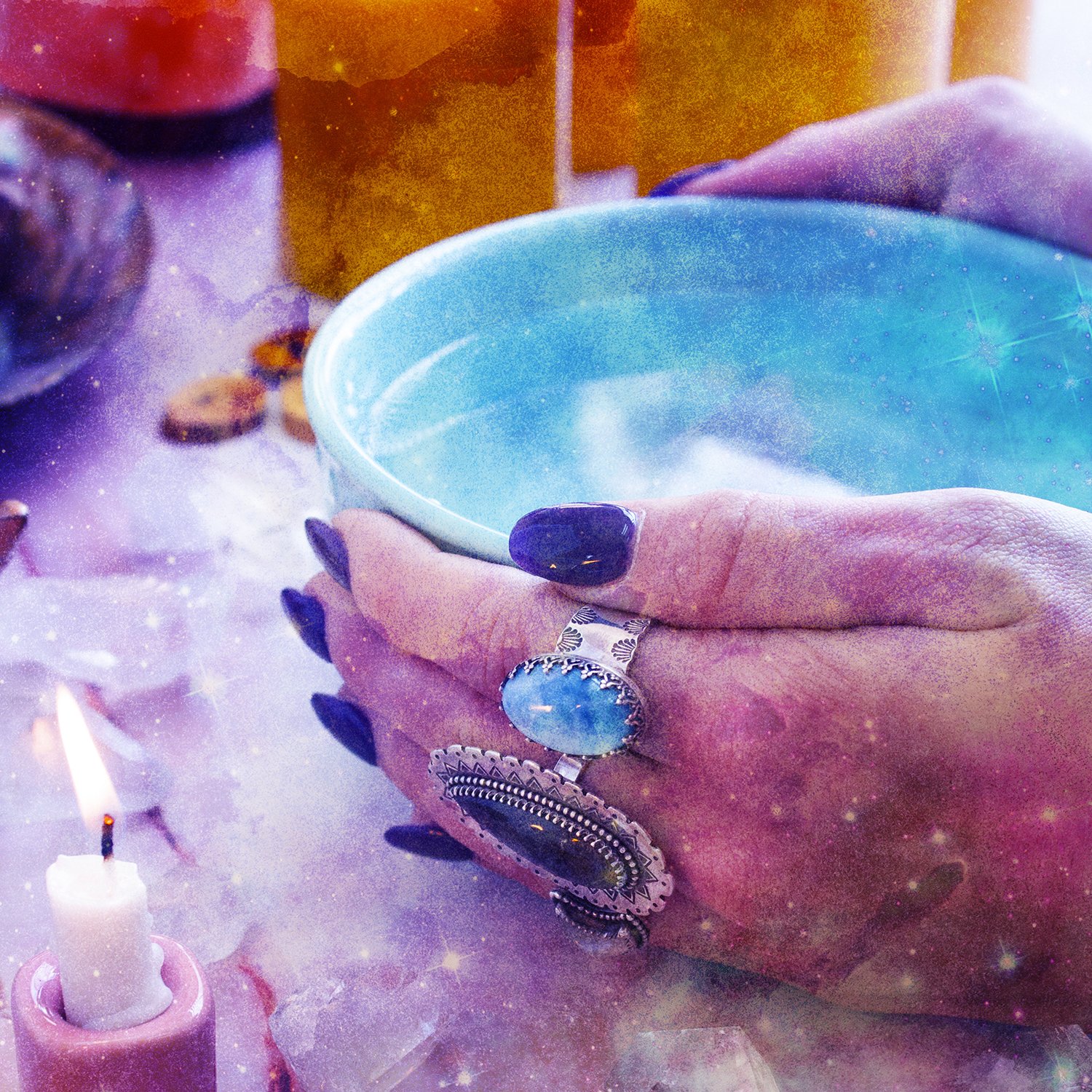
Remember, the subconscious mind works with symbolism, so don’t discount anything that you see even if you’re not quite sure what it means at first! Think of the information you receive, like the symbolism in dreams: sometimes we are left with more questions than answers. Sometimes the questions are the answers. Sometimes a thread is what you are offered, and you can choose to follow it or not. Sometimes symbols may not mean anything at first but are asking to be engaged with over time.
Let the process unfold, and see what comes up for you!
